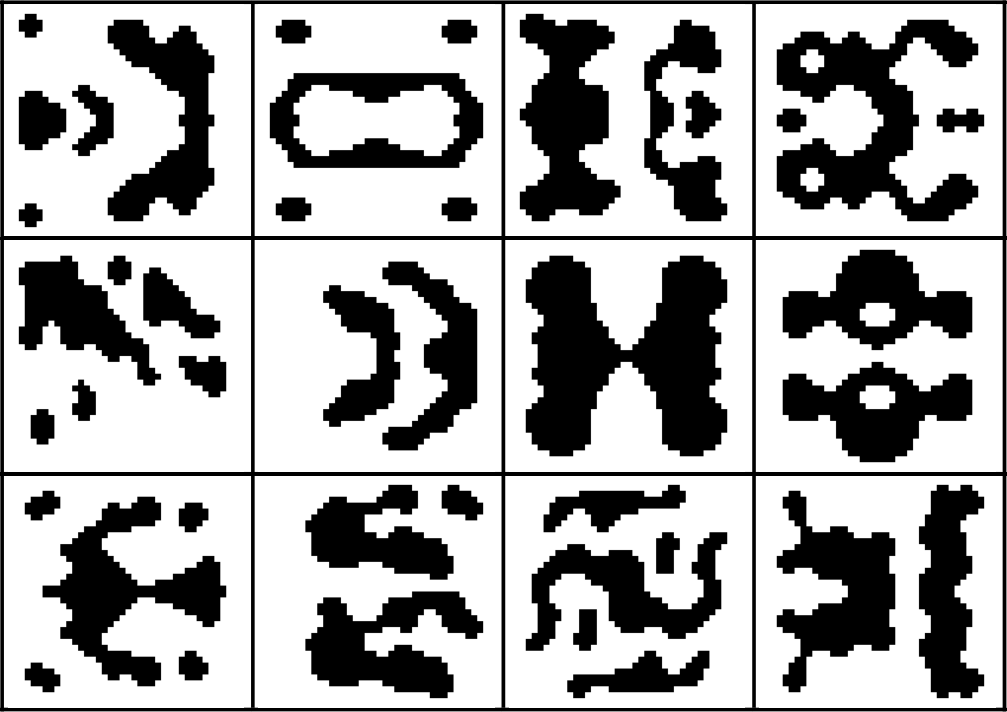
Board game play is enhanced through technology for the purposes of time-keeping in games such as One-Night Werewolf, logistics for e.g. hit point tracking in Hero Realms or revealing hidden information in Alchemists, new mini-games such as the digital puzzles in Mansions of Madness, and randomization.
Randomization could be considered a form of procedural content generation, although it often follows a simple digital variant of shuffling a deck or looking up values in a table. While randomization speeds up preparation in long games such as Mansions of Madness and ensures information stays hidden in Alchemists, it does not particularly contribute to novel gameplay. The generated content (i.e. the event sequence or board) forms a backdrop for traditional game mechanics (dice-rolling, token placement, etc.) and only indirectly affects the player experience.
In order to explore different uses of generated content in board games, I designed a game ultimately titled Alien Transmission where symbols are generated and players must use them to communicate information to each other. This 4-player game has a science-fiction theme and hinges on co-operation for survival against an external invasion. Each player controls one sector of a solar system with two planets (one outer, one inner) and one starbase. Planets can hold population, fortifications or infiltrated aliens, while starbases can hold spaceships. Planets with no population are considered fallen, and if all players' planets fall the game is over. In the current prototype, players must choose one action per turn (from a set of 12 actions) and choose one of their two planets or neighboring sectors where this action is issued. Actions include building spaceships to send to the starbase, sacrificing population to guard against alien threats, sending population or spaceships to players of neighboring sectors, etc.

Actions are taken in response to upcoming alien threats, which may add infiltration tokens to planets (replacing population, if the planet's capacity is full), remove spaceships or population under circumstances (e.g. if there is no fortification or if there is an infiltrated alien on a planet), halve a planet's population unless a quarantine player action is taken, etc. Each player places one action card face down on the relevant planet or neighboring sector on their control panel. Players reveal their action cards simultaneously during the resolution phase, after the alien threat has been shown. Players win if a deck of 20 alien threats is depleted and at least one planet has not yet fallen.
While the board, player actions and randomized alien threat deck are reminiscent of many co-operative survival games such as Pandemic and Arkham Horror, the key mechanics of Alien Transmission revolve around one player's advance knowledge of the threat and their efforts to warn some or all players. In every turn, one player reads the next alien threat card and must choose which player(s) and which message to transmit to them in order to take the right actions to counter it (if possible). The message itself is where procedural content generation comes in: messages consist of one or more symbols with no meaning ascribed beforehand. The symbols themselves are in black and white and generated via cellular automata with the occasional hard-coded symmetry, rotation, reflection etc. [The codebase for generating your own symbols, and other possible uses, is found at https://github.com/sentientdesigns/aliensymbols.]
A pool of 12 different symbols (with duplicates) is available to all players in each game: players may need to develop a common code to decipher them through prolonged interaction during the same game. Players are not allowed to speak — at least not to discuss the symbols themselves or talk about the alien threat. As an example, the first player may wish to notify another player about an upcoming alien virus threat to that player's inner planet: they choose a vaguely skull-shaped symbol and a teardrop-shaped symbol for a message transmitted only to that player but visible to all. Even if the other player fails to decipher it and counter the threat (e.g. via a quarantine action), during resolution all players see the alien threat card and figure out what the message was about. Optimally, other players should use the same symbols in their turns if they wish to communicate a virus attack (although message details such as the planet it is aimed at may change).
The role of procedural content generation in this game is not to randomize the initial state or to handle game-state progression (both are handled in a traditional way by shuffling the alien threat deck). Finding patterns in the randomly generated symbols (ambiguous black splotches on white paper, much like Rorschach tests) and constructing a common language out of them is the core challenge and the core mechanic of the game. Deciphering or combining ambiguous images or semantics has been used in boardgames such as Dixit, Codenames or Cards Against Humanity, and forming a co-operative shared lexicon of abstract visuals is vital in Mysterium and Codenames: Pictures.

Alien Transmission uses generated abstract symbols instead of pre-authored ones, although admittedly the same could be accomplished by running the algorithm once (producing many symbols) and using a combination of 12 symbols in each game [This was how the playtest version for the Global Game Jam took place, as printing and cutting new symbols on the fly required too much downtime].
Notably, the generated black-and-white symbols are much more abstract than the evocative, colorful images of Dixit or Codenames: Pictures which are grounded in real-world representations (however dream-like). The more abstract nature of the symbols, the lack of real-world grounding, and the underlying algorithmic principles (smoothened curves due to cellular automata, emergent dots and splotches, symmetries and rotations) need to be incorporated into the players' association between perception (the visual symbol) and cognition (the underlying message). Generated content thus becomes part of the "grain" that players need to work with to win as it directly affects the core mechanic (transmitting a message).
Find the prototype cards, board and manual for Alien Transmission at http://alientransmission.antoniosliapis.com.